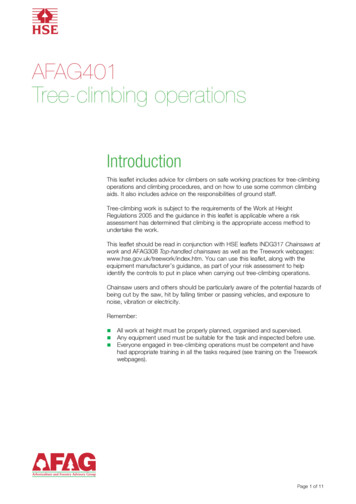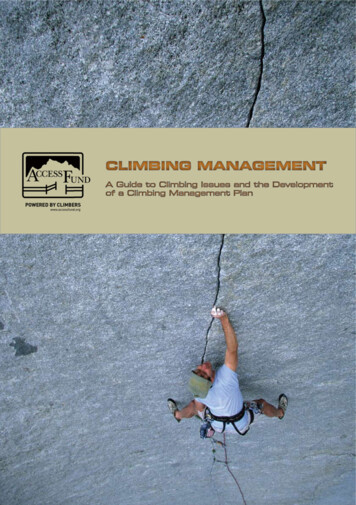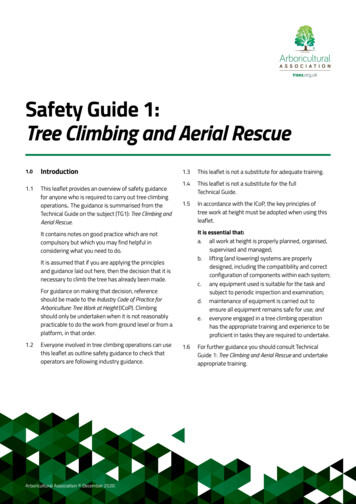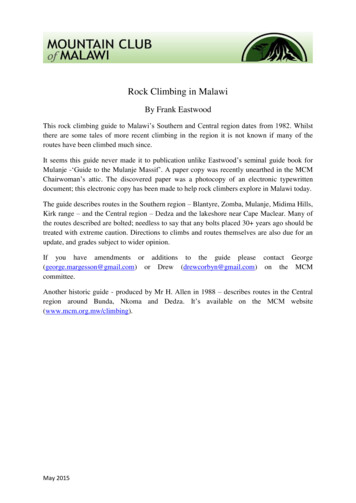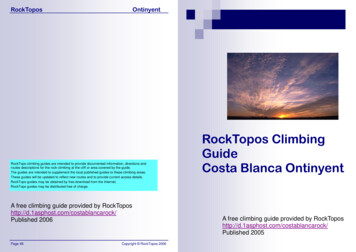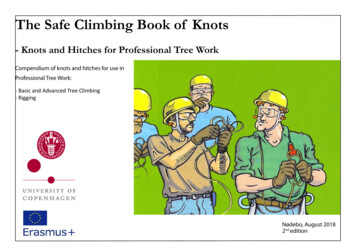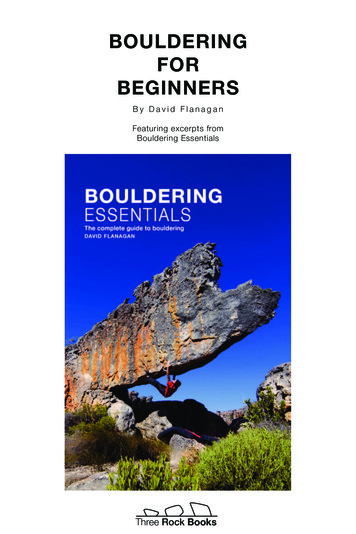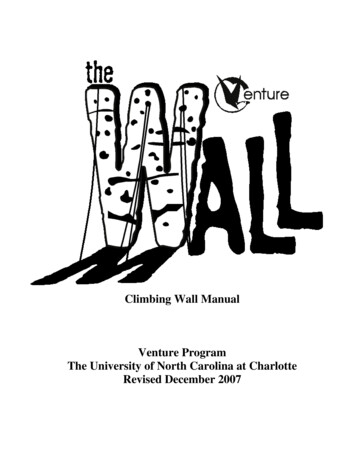
Transcription
CLIMBING
BOY SCOUTS OF AMERICAMERIT BADGE SERIESCLIMBING“Enhancing our youths’ competitive edge through merit badges”
(b) Name at least five different types of governments currently in powerin the world.(c) Show on a world map countries that use each of these five different formsof government.6. Do the following:(a) Explain how a government is represented abroad and how the UnitedStates government is accredited to international organizations.(b) Describe the roles of the following in the conduct of foreign relations.(1) Ambassador(2) Consul(3) Bureau of International Information Programs(4) Agency for International Development(5) United States and Foreign Commercial Service(c) Explain the purpose of a passport and visa for international travel.7. Do TWO of the following (with your parent’s permission) and share with yourcounselor what you have learned:(a) Visit the website of the U.S. State Department. Learn more about an issueyou find interesting that is discussed on this website.(b) Visit the website of an international news organization or foreigngovernment, OR examine a foreign newspaper available at your local library,bookstore, or newsstand. Find a news story about a human right realized inthe United States that is not recognized in another country.(c) Visit with a student or Scout from another country and discuss the typicalvalues, holidays, ethnic foods, and traditions practiced or enjoyed there.(d) Attend a world Scout jamboree.(e) Participate in or attend an international event in your area, such as anethnic festival, concert, or play.Climbing1. Do the following:(a) Explain to your counselor the most likely hazards you may encounterwhile participating in climbing and rappelling activities and what you shoulddo to anticipate, help prevent, mitigate, and respond to these hazards.(b) Show that you know first aid for and how to prevent injuries or illnessesthat could occur during climbing activities, including heat and cold reactions,dehydration, stopped breathing, sprains, abrasions, fractures, rope burns,blisters, snakebite, and insect bites or stings.(c) Identify the conditions that must exist before performing CPR on a person.71
2. Learn the Leave No Trace principles and Outdoor Code, and explain whatthey mean.3. Present yourself properly dressed for belaying, climbing, and rappelling (i.e.,appropriate clothing, footwear, and a helmet; rappellers can also wear gloves).4. Location. Do the following:(a) Explain how the difficulty of climbs is classified, and apply classificationsto the rock faces or walls where you will demonstrate your climbing skills.(b) Explain the following: top-rope climbing, lead climbing, and bouldering.(c) Evaluate the safety of a particular climbing area. Consider weather,visibility, the condition of the climbing surface, and any otherenvironmental hazards.(d) Determine how to summon aid to the climbing area in case of an emergency.5. Verbal signals. Explain the importance of using verbal signals during everyclimb and rappel, and while bouldering. With the help of the merit badgecounselor or another Scout, demonstrate the verbal signals used by each ofthe following:(a) Climbers(b) Rappellers(c) Belayers(d) Boulderers and their spotters6. Rope. Do the following:(a) Describe the kinds of rope acceptable for use in climbing and rappelling.(b) Show how to examine a rope for signs of wear or damage.(c) Discuss ways to prevent a rope from being damaged.(d) Explain when and how a rope should be retired.(e) Properly coil a rope.7. Knots. Demonstrate the ability to tie each of the following knots. Giveat least one example of how each knot is used in belaying, climbing,or rappelling.(a) Figure eight on a bight(b) Figure eight follow-through(c) Water knot(d) Double fisherman’s knot (grapevine knot)(e) Safety knot8. Harnesses. Correctly put on a commercially made climbing harness.9. Belaying. Do the following:(a) Explain the importance of belaying climbers and rappellers and when itis necessary.(b) Belay three different climbers ascending a rock face or climbing wall.72
(c) Belay three different rappellers descending a rock face or climbing wallusing a top rope.10. Climbing. Do the following: (a) Show the correct way to directly tie into a belay rope. (b) Climb at least three different routes on a rock face or climbing wall,demonstrating good technique and using verbal signals with a belayer.11. Rappelling. Do the following: (a) Using a carabiner and a rappel device, secure your climbing harness to arappel rope.(b) Tie in to a belay rope set up to protect rappellers. (c) Rappel down three different rock faces or three rappel routes on a climbing wall. Use verbal signals to communicate with a belayer, and demonstrategood rappelling technique.12. Demonstrate ways to store rope, hardware, and other gear used for climbing,rappelling, and belaying.Coin Collecting1. Understand how coins are made and where the active U.S. Mint facilitiesare located.2. Explain these collecting terms:(a) Obverse(b) Reverse(c) Reeding(d) Clad(e) Type set(f) Date set3. Explain the grading terms Uncirculated, Extremely Fine, Very Fine, Fine, VeryGood, Good, and Poor. Show five different grade examples of the same coin type.Explain the term proof and why it is not a grade. Tell what encapsulated coins are.4. Know three different ways to store a collection, and describe the benefits,drawbacks, and expense of each method. Pick one to use whencompleting requirements.5. Do the following:(a) Demonstrate to your counselor that you know how to use two U.S. orworld coin reference catalogs.(b) Read a numismatic magazine or newspaper and tell your counselorabout what you learned.73
Climbing Resources.Climbing ResourcesScouting LiteratureDeck of Knots; Basic Illustrated Knotsfor the Outdoors; Boy Scout Handbook;Project COPE manual; Climb On Safely;and Topping Out: A BSA Climbing/Rappelling ManualFor more information about or toorder Scouting-related resources,visit http://www.scoutstuff.org(with your parent’s permission).Long, John. How to Rock Climb! GlobePequot Press, 2010.———. Climbing Anchors. ChockstonePress, 1993.Loughman, Michael. Learning to RockClimb. Random House, 1982.Luebben, Craig. Knots for Climbers.Falcon, 2011.———. Rock Climbing: Mastering BasicSkills. Mountaineers, 2004.Instruction and GuidebooksMellor, Don. Rock Climbing: A TrailsideGuide. W. W. Norton, 1997.Allen, Linda B. High MountainChallenge: A Guide for YoungMountaineers. AMC Books, 1989.Roper, Steve, and Allen Steck. FiftyClassic Climbs of North America.Sierra Club, 1996.Burbach, Matt. Gym Climbing:Maximizing Your Indoor Experience.Mountaineers Books, 2004.Sherman, John. How to Rock Climb:Better Bouldering, 2nd ed.Falcon, 2012.Cox, Steven, and Kris Fulsaas, eds.Mountaineering: The Freedom of theHills, 7th ed. Mountaineers, 2003.Skinner, Todd, and John McMullen.Modern Rock Climbing: Beyond theBasics. ICS Books, 1993.Fawcett, Ron, et al. The Climber’sHandbook: Rock, Ice, Alpine,Expeditions. Sierra Club, 1987.Takeda, Pete. Extreme Sports: Climb.National Geographic, 2002.Lewis, S. Peter. Climbing: From Gym toCrag, Building Skills for Real Rock.Mountaineers, 2000.94 CLIMBINGToula, Tim. Rock ‘N’ Road: An Atlas ofNorth American Rock ClimbingAreas, 2nd ed. Falcon, 2003.
.Climbing ResourcesVoeller, Edward A. Sport Climbing.Capstone Books, 2000.Wilkerson, James A., ed. Medicine forMountaineering and OtherWilderness Activities, 6th ed.Mountaineers, 2010.History and BiographyBonington, Chris. Mountaineer: ThirtyYears of Climbing on the World’sGreat Peaks. Sierra Club, 1996.Curran, Jim. K2: Triumph and Tragedy.Houghton Mifflin, 1987.Fraser, Mary Ann. On Top of the World:The Conquest of Mount Everest.Henry Holt, 1991.Jones, Chris. Climbing in North America.Mountaineers Books, 1997.Krakauer, Jon. Into Thin Air: A PersonalAccount of the Mount EverestDisaster. Anchor Books, 1998.MacDonald, Dougald, ed. The Best ofRock and Ice: An Anthology.Mountaineers Books, 1999.Messner, Reinhold. The CrystalHorizon: Everest —The First SoloAscent. Mountaineers Books, 1989.Sherman, John. Stone Crusade: AHistorical Guide to Boulderingin America. American AlpineClub, 1999.Weihenmayer, Erik. Touch the Top ofthe World: A Blind Man’s Journey toClimb Farther Than the Eye Can See:My Story. Plume, 2001.Whittaker, Jim. A Life on the Edge:Memoirs of Everest and Beyond.The Mountaineers, 1999.PeriodicalsClimbing Magazine2520 55th St.,Suite 210Boulder, CO 80302Telephone: 303-625-1600Website: http://www.climbing.comOrganizations andOnline ResourcesMountain Project2525 Arapahoe Ave. #E4-715Boulder, CO 80302Website:http://www.mountainproject.comRosen, Mike. The Conquest of Everest.Bookwright Press, 1990.CLIMBING 95
to the rock faces or walls where you will demonstrate your climbing skills. (b) Explain the following: top-rope climbing, lead climbing, and bouldering. (c) Evaluate the safety of a particular climbing area. Consider weather, visibility, the condition of the climbi
